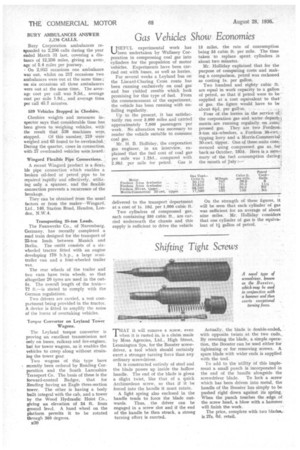Gas Vehicles Show Economies
Page 30

If you've noticed an error in this article please click here to report it so we can fix it.
USEFIJL experimental work has been undertaken by Wallasey Corporation in compressing coal gas into cylinders for the propulsion of motor 'vehicles. Experiments have been carried out with buses, as well as lorries.
For several weeks a Leyland bus on the Liscard-Charing Cross route has been running exclusively on coal gas and has yielded results which look promising for this type of fuel. From the commencement of the experiment, the vehicle has been running with unfailing regularity.
Up to the present, it has satisfactorily run over 3,000 miles and carried approximately 7,000 passengers per week. No alteration was necessary to render the vehicle suitable to consume coal gas.
Mr. H. B. Holliday, the corporation gas engineer, in an interview, explained that the fuel -cost of coal gas per mile was 1.25d., compared with 2.36d. per mile for petrol. Gas is delivered to the transport department at a cost of Is. 10d. per 1,000 cubic ft.
Two cylinders of compressed gas, each containing 350 cubic ft., are carried underneath the chassis and this supply is sufficient to drive the vehicle 13 miles, the rate of consumption being 55 cubic ft. per mile. The time taken to replace spent cylinders is about two minutes.
Mr. Holliday explained that for the purpose of computing costs and making a comparison, petrol was reckoned as costing is. per gallon.
Two hundred and eighty cubic ft. are equal in work capacity to a gallon of petrol, so that if petrol were to be. supplied at a cost equivalent to that of gas, the figure would have to be
about 60. per gallon. ,
Four of the lorries in the service of the corporation gas and water depart..:‘, ments are running regularly on ,corrn' pressed gas. They are two Fordsoo 3-ton six-wheelers, a Fordson 30-cwt.-tipping lorry and a Morris-Commerciak‘ 30-cwt. tipper. One of these units corny, menced using compressed gas as far" back as October, 1934. Here is a sum mary of the fuel consumption during, the month of July
On the strength of these figures, it will be seen that each cylinder of gas was sufficient for an average of about nine miles. Mr. Holliday considers that one cylinder of gas is the equivalent of 11 gallon of petrol.




















































































